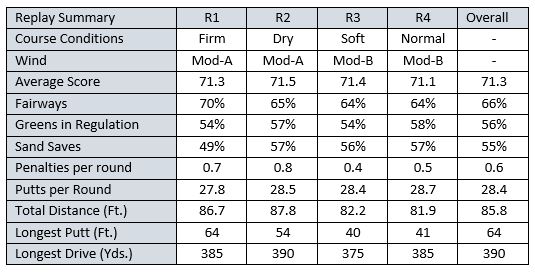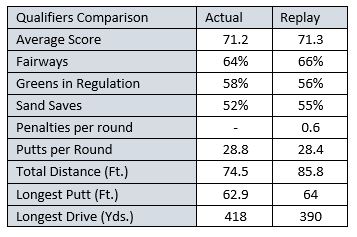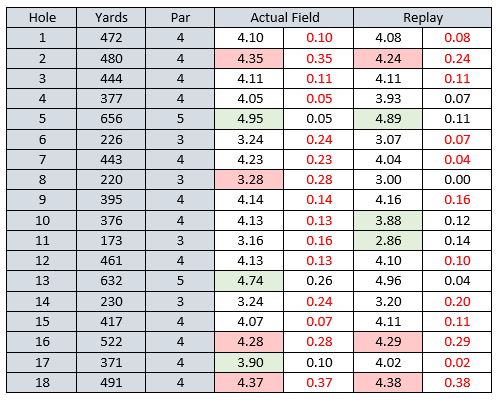This post is the last in a 6-part series on my replay of the 2022 PGA Championship at Southern Hills (Sooner Hills). The initial post detailed the day conditions, course layout, and strategy for playing Sooner Hills. It also described the conditions and Master Game rules that were in effect for the replay. Later posts did a round-by-round comparison of the replay with the actual event. (See round results 1, 2, 3, and 4.)
The first three rounds were played with Game Caddie versions 5.2 and 5.3. The final round was played with Game Caddie version 6.0 (in beta form).
Comparison of Overall Actual and Replay Results
Despite a shift in the prevailing wind direction and changes in course conditions during the four days of the replay tournament, average scores remained generally consistent on this par 70 course–varying from a low of 71.1 strokes in round 4 to a high of 71.5 strokes in round 2. The changes in pin locations did not seem to affect putting results significantly, with average putts per round ranging from a low of 27.8 putts in round 1 to a high of 28.7 putts in round 3. The Major Tournament Putting boards were in effect for this replay.
After round 1, Fairway and Greens in Regulation percentages also varied little during the remainder of the replay tournament. A “practice effect” may explain a drop in penalty strokes between rounds 1 & 2 and rounds 3 & 4, as players hedged somewhat by bailing out on holes where experience showed it didn’t pay to play over aggressively. The results of each round are shown below.

As with previous replay tournaments I’ve conducted, when the field of both replay and actual players contains nearly the same set of players and the tournament is played under a similar setup and conditions, the overall results are also quite similar. Since APBA ratings are limited to the 80-card set and the actual field had 156 players, tracking results to qualifiers provides a more representative framework for comparison.
In this case, the actual tournament had 79 qualifiers, with one withdrawal (Tiger Woods) after round 3. The replay used the 69 players from the 2022 card set who also played in the actual tournament.
For the qualifiers, overall scores were nearly the same (71.3 for both actual and replay golfers). The replay golfers hit a few more fairways (66%) than the actual players (64%), while the replay golfers hit fewer greens (56%) than the actual players (58%).
The replay golfers got up and down from the sand (55%) somewhat more often than did the actual players (52%). The PGA doesn’t report penalty strokes, so a direct comparison of that statistic is not possible. Putts per round were remarkably similar—28.8 actual vs 28.4 replay. Longest putts made and drives matched closely as well.
The Total Distance of Putts Made statistic was different, though. Previous analysis has shown that the Major Tournament Putting boards can add about 2 strokes per round. The Major Tournament Putting boards are designed to make missed putts longer and thus increases the probability of a 3-putt or worse when going for it.
With longer follow-up putts, the overall length of putts made in a round tends to be greater than with the Regular Putting boards. That may explain why the Total Distance of Putts Made for the replay golfers was 10.3 ft. longer than the actual players (85.8 ft. vs. 74.5 ft.).
The overall results for qualifiers and replay golfers across statistical measures are shown below.

Comparison of Hole Difficulty
Available data on the actual strokes per hole included all 156 players in the field. Thus, a direct comparison of holes scores for actual qualifiers vs. replay golfers was not possible. The average score for the total field in the tournament was 72.5 strokes vs. 71.2 strokes for the actual qualifiers (a 1.3 stroke difference). This upward skew makes the absolute number of strokes per hole a bit higher than what would be shown for the actual qualifiers had that breakdown been available.
Nevertheless, on a relative scale, we find that the three most difficult holes for both actual and replay golfers were No. 16 (or No. 8 for actual players), No. 2, and No. 18–with No. 18 serving as the most difficult hole for both groups.
By contrast, No. 13, a 636-yard par 5, was the easiest for the actual field. Thereafter, No. 17 and then No. 5 (a 656-yard par 5) were the next easiest holes for the actual field. The replay players found No. 11 the easiest, followed by No. 10 and No. 5.
What’s important to note is how few holes played under par for either group. Southern Hills (Sooner Hills) is a very challenging course to play for either the actual PGA professionals or a replay group played under APBA Master Game rules.
Another takeaway is how well the course designer for Sooner Hills did in capturing the absolute and relative difficulty of nearly every hole. (Notable exceptions include the short par 4 No. 10 and the shortest of the par 3’s, No. 11, which the actual players found challenging and the replay golfers found easiest.) The table below provides a hole-by-hole comparison.

In my view, Sooner Hills is a good course for more experienced APBA Golf players. Newer ones may find the quartering wind rules and many hole notes a bit overwhelming–at least at first. This problem can be overcome though, by ignoring the course notes and/or playing Sooner Hills using the Game Caddie’s Basic Rules mode in version 6.0.